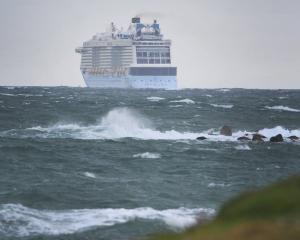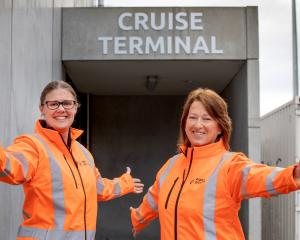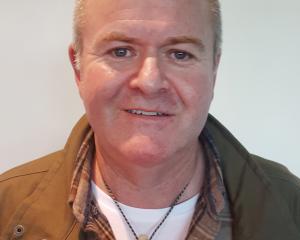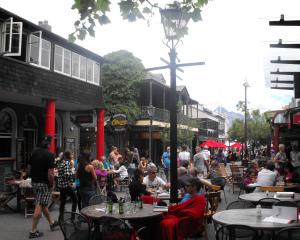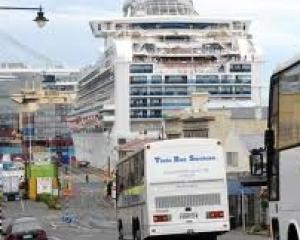
Dunedin city councillor Paul Hudson is one who believes Dunedin is being overtaken by other "ports of call" vying for a bigger slice of the trade. Mark Price backgrounds some of the issues.
Cruise-ship passengers are a big chunk of Steve McNulty's bread and butter.
One summer morning 16 years ago he took the three classic Jaguar cars he used for his part-time wedding service down to the wharves at Port Chalmers and lined them up alongside a cruise ship.
He was noticed and he got a contract.
And now, in a convoy of up to 10 classic Jaguars, he can ferry 36 cruise-ship passengers around the sights - 28% of his annual income generated from 50 or 60 days a year of cruise-ship work.
"Our record turnover days are generally a cruise-ship day. We had one last year, so they are pretty important to our business."
Not surprisingly, Mr McNulty believes the city needs to treasure its cruise-ship visits.
"I know from the people we carry the kind of spend that goes on in the city on a cruise day. It's huge.
"The city needs to get behind the cruise industry and make sure that the Dunedin experience is always a good experience."
In February last year, University of Otago researcher Nikki Lloyd was sent on a Tourism Dunedin-funded cruise around New Zealand aboard the Dawn Princess.
She and two other researchers on two other cruises brought back impressions of New Zealand and Dunedin from the passengers' points of view. Their research is now being used in a cruise-ship strategy being drawn up for Dunedin.
A final draft is expected to be in front of the main industry players within weeks.
Ms Lloyd interviewed 150 passengers and found a new breed of cruise-ship passenger with a broader range of characteristics than once might have been the case.
Many were retired but plenty were younger.
Some were American (3%) but mostly they were Australian (84%).
Some had a few bob to spend but many were what Ms Lloyd describes as "backpacking Australians".
"They sort of spent all their money on the cruise and were very cautious about how much they spent in each port.
"They would catch the local bus into town or the bus provided by the city council and just wander around all day.
"They were just ordinary Australians."
But those ordinary Australians were, in themselves, quite a diverse lot with many of Greek, Italian or Asian origin.
And each had their own preferred way of going ashore.
Some liked to be independent, some preferred organised tours, some preferred to travel in large groups and, of course, some did not.
How to cater for this diversity is a question confronting cruise-ship ports around the globe as extraordinary numbers of people hit the high seas and each morning wake up in a new, exotic locale - such as George St, Port Chalmers.
Making sure Dunedin presents a highly polished image to cruise-ship visitors - so they keep on coming - is one of the jobs of Tourism Dunedin chief executive Hamish Saxton.
Cruise ships will be one of 30 aspects of Dunedin tourism discussed at a tourism "summit" on Wednesday.
In some places, - Auckland, Melbourne, Brisbane and Sydney - huge sums have been or are being spent on "terminal" buildings to make cruise-ship passengers more comfortable as they join or depart from their cruise ships.
Port Chalmers, where passengers walk down an open gangway, often to a wharf dominated by a pile of woodchips waiting to be exported, is merely a "port of call" and seemingly requires no multimillion dollar "hub".
And Mr Saxton suggests the new cruise-ship strategy will therefore deal more with processes than buildings.
"This is about assisting in the dispersal and distribution of passengers and that's quite, quite different to what Auckland is doing.
"They are dealing with bags - as well as people - and freight and a welcome to New Zealand.
"We've got the second-highest visited port in New Zealand - it's either the first or the last port visited - but we aren't the destination people fly into."
Mr Saxton considers the goal here is to ensure passengers have "the best possible day" while in Dunedin and return to their ship saying: "Gee, Dunedin is friendly, efficient; nothing was a problem. We had a neat time. We can't wait to come back."
So, Dunedin ratepayers can probably expect the strategy will be about doing the small things well rather than about spending the big dollars.
Dunedin city councillor Paul Hudson hopes the strategy will produce "a clear identification of the main reasons why Dunedin has fallen in the New Zealand preferred destinations and the worldwide preferred destinations".
He believes it is not that Dunedin is doing things less well than it used to but that ... "what we have always done before is not always good enough because others are responding to the requirements of cruise-ship passengers by improving their services.
"I think we need to look at how we can up our game a little bit."
In her February 2009 report, Ms Lloyd said some passengers were left "dazed and confused" by the process of getting from their ship to their land transport.
Dunedin Visitor Centre team manager Louise van de Vlierd represents those who deal with the thousands of passengers at Port Chalmers that might fit that description.
She says criticisms in Ms Lloyd's report have been acted on - such as improving the visibility of the container i-Site - and "tweaking" would continue as required.
Although already somewhat out of date, Ms Lloyd's report appears still to be the best available information about how passengers view Dunedin.
These are some of the areas they and researchers believe Dunedin could do better:
• SHUTTLE BUSES
Having been ferried from Napier's cruise-ship berth into the city in a free shuttle bus with an entertaining commentary, Ms Lloyd questions the lack of commentary on shuttles between Port Chalmers and Dunedin city.
She believes the role of drivers was "huge" and not generally appreciated.
"We have the passengers captured on the bus as it's coming up from Port Chalmers. I think we need to push ourselves as a city more during that time. There's certainly huge potential to do it and my research showed it wasn't done."
In her research paper on the role of bus drivers, Ms Lloyd states: "For many [cruise-ship passengers], the bus driver is the only real local they meet; the only chance to truly learn about the destination ..."
She believes some people - particularly growing numbers of families on cruises - would be put off entering Dunedin city because of the $7 one-way shuttle-bus fare (compared with the public bus fare of $2.70).
"Some passengers chose to spend their day in Port Chalmers only and returned to the ship after a short time."
• MAORI WELCOME
Dunedin is either the first or last port of call on the New Zealand leg of cruises and Ms Lloyd found "a large number" of passengers were expecting a Maori cultural greeting or farewell.
"A stronger presence of indigenous culture is highly demanded by all passengers ..."
Ms van de Vlierd: "It's a wee bit hard ... we don't have a large indigenous population in Dunedin.
"To be honest, it's not anything they've actually voiced to us. Interesting."
Cr Hudson acknowledges the small size of Dunedin's indigenous population and the lack of space at Port Chalmers for a Maori welcome.
He believes support for the Scottish pipers needs to be strengthened.
"I wonder if we are past the stage now of expecting people to do things on a semi-volunteer basis."
• SHELTER
Cruise ships provide just 3% of Port Otago's revenue and therefore the company sees no economic argument for providing flash facilities at Port Chalmers.
Three years ago it turned part of a shed used for packing containers into an area where passengers can wait for their buses.
Ms van de Vlierd said it was for the cruise-ship operator to decide how its passengers were collected.
"I've seen them when they've had people actually lining up out in the cold and wet ...
"It's one of these areas where we [Dunedin] sometimes take the blame and yet it's actually calls that are made by the actual cruise line."
• SOUVENIRS AND TOURS
Because Dunedin can be the last port of call in New Zealand for passengers, Ms Lloyd believed they wanted more opportunity to buy souvenirs at the wharf. Passengers told her they had too little time to shop for "a taste of New Zealand".
Some "appreciated" the crafts for sale at the Octagon market while "others felt they had seen the same crafts in other parts of New Zealand and even Australia".
Some found it difficult to buy "simple and plain" food such as sandwiches.
• HIRE CARS
Ms Lloyd reported some passengers were disappointed hire cars were not available at Port Chalmers.
• PORT FACILITIES
Some passengers told Ms Lloyd they would have liked toilets and internet services at the wharf and some were disappointed with the "sporadic timetable" and lack of seats on public buses.
• INFORMATION
Ms Lloyd said passengers needed maps specifically designed for them showing toilets, internet access, shops, cafes, local attractions, bus stops and information centres. Cruise-ship maps were out of date.
Also, information prior to port visits was given by an Australian crew member and it was not always accurate or authentic.
• WOODCHIPS
University of Otago tourism PhD student Wendy London, in a paper from March this year, reported one cruise line considered "dedicated berths and terminals" were necessary if New Zealand was to "display a professional image" and that "with the exception of Tauranga", New Zealand ports were "not cruise-friendly."
An unnamed cruise-line official gave as examples Lyttelton where "everything is covered in a fine black coal dust" and Dunedin "where wood chips blow on everything".
Ms van de Vlierd agreed the wood chips did blow around and they could be "a bit of a nuisance" but they were also "a great talking point".
"They [passengers] actually find it quite fascinating, quite interesting. It tells them something about us and about our economy.
"I don't know that we hear that many people bitterly complaining about it."
Ms London told the Otago Daily Times she was not advocating the building of a cruise terminal at Port Chalmers.
However, ships and passengers getting dirty from such things as dust from coal and wood was not welcome and where practical, ports needed to look at separating cruise passengers from other port activities.
"That's why Napier and Tauranga are taking great care to at least segregate, to the extent they can, the commercial wharf from the cruise-terminal wharf."
• CITY ARRIVAL POINT
Cruise-ship passengers are usually delivered to the central carriageway of the Octagon.
Cr Hudson believes better quality barriers - perhaps bollards - need to be used to improve the look of the area.
Mr McNulty says it has been suggested the new Forsyth Barr Stadium be used as a "staging post".
Ms van de Vlierd was not in favour.
"All it is, is getting them on and off a bus yet again.
"If 2000 people are going to get off a ship ... they're still going to have some congestion at Port Chalmers."
• WHO PAYS?
Should not the cruise ship operators and their passengers pay for new facilities?
Wendy London in her PhD traced Alaska's experiment with that approach.
In 2006, Alaska (catering for a million passengers each year) imposed a $50 "head tax" and also a 33% tax on gambling profits made by cruise ships in Alaskan waters.
The cruise ship industry started court action claiming the money was not being spent on the facilities it was intended for and it also reduced cruises - leading to a drop of 140,000 passengers.
The tax remains in place.
The Port of Lyttelton is reportedly set to impose a $4.95 head tax from January 1.
Ms London believes the impact of a new tax must be carefully evaluated.
During the recession, cruise-ship operators faced with passengers counting every "nickel and dime" discounted substantially and there was considerable resistance to anything that affected cruise-ship ticket prices.
• WHAT'S ON?
Are cruise-ship passengers getting enough spending opportunities in Dunedin?
Dunedin visitor centre team manager Louise van de Vlierd says this year Dunedin had "absolutely plenty of product".
"And the cruise passengers themselves didn't have the disposable dollar because this year the cruises were really topped up with a lot of budget fares."
Tourism Dunedin chief executive Hamish Saxton says Dunedin has more "products" for sale than other ports but as passenger numbers increase, Dunedin businesses can use simple marketing techniques such as putting welcome messages in their windows.
"There are certainly going to be some commercial opportunities that come out of this."
Steve McNulty, of Classic Jaguar Limousines, believes it is important to offer a professionally run business.
"It's not just being down there (at the cruise ship) and being seen, it's having a product that is distinctive and different.
"It's not so easy to break into it now."
• HOW WE RANK
Passenger survey figures quoted by Cruise New Zealand for 2009-10 show of 81 ports world wide, Dunedin was rated 24th for "overall enjoyment".
Fiordland National Park was third, Napier 8th, Tauranga 13th, Christchurch 14th, Auckland 25th, Bay of Islands 30th, Wellington 34th, Akaroa 51st and Gisborne 70th.
Dunedin was 32nd for "overall quality of shore excursions".
Figures for previous years were not available this week.

